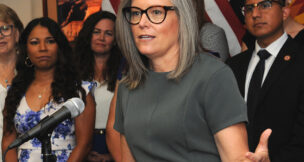GOP touts $2.5B in tax cuts, but critics say Arizona can’t afford them
Luige del Puerto//June 4, 2012//[read_meter]
GOP touts $2.5B in tax cuts, but critics say Arizona can’t afford them
Luige del Puerto//June 4, 2012//[read_meter]
Policymakers often point to the state’s conservative spending plan that eschewed accounting gimmicks and set aside money for rainy days as the biggest victory of the Republican supermajority. But the...
No tags for this post.

















